The Howard Francis carbine was a design submitted to the British Ordnance Board for consideration in 1943 – one of many weapons proposed to help meet wartime requirements. Specifically, the Howard Francis carbine was a conversion of a bolt action SMLE into a semiautomatic pistol caliber carbine.
Chambered for the 7.63mm Mauser cartridge (the same as used in the C96 Broomhandle Mauser pistol), the conversion was done by plugging the chamber of a .303 Enfield barrel and then re-reaming it to fit the pistol cartridge. If you are wondering why the 7.63mm Mauser was used instead of the more potent but dimensionally identical 7.62×25 Tokarev, consider that the Tokarev cartridge was not in common use in England at the time, while C96 pistols were well known and popular. The 7.63mm bore was close enough to the .303 to allow its use without altering the actual bore of the barrel.
Anyway, the mechanical action of the carbine was quite simple. In place of the regular turning bolt, a heavy blowback bolt sans locking lugs was made. A tubular extension out the back of the action contained a recoil spring (rather like the Soviet DPM) and the extension locked into the rear locking lug recesses of the receiver – a clever use of those existing features. Upon firing, the heavy square breechblock assembly would simply blow backwards against the recoil spring. Its striker would reset, and be ready to fire again with another trigger pull. The prototype examples made were semiautomatic, not fully automatic.
The barrel was cut back to 12.75 inches (324mm) to make the weapon handier, and the final product weighed in at 8 pounds, 1.5 ounces (3.7kg). Not much less than a standard rifle, which would make it feel virtually recoil-free to shoot, I expect.
Approximately the front third of the original .303 magazine was removed, and the remaining portion of the magazine used as simply a filler block in the action. The magazine actually feeding the system was a 12-round proprietary design similar to the Browning High Power magazines in use by British forces (but not identical, because 7.63mm Mauser is too long to fit in a 9mm Parabellum magazine). The example pictured below does not have a magazine, unfortunately.
Reportedly the weapon was tested from 30 out to 200 yards and was pretty accurate (not surprising from a fixed barrel carbine, really, even though the rear sight was a simple open V notch mounted on the moving breechblock). However, it suffered from feeding and extraction problems – also not surprising for a prototype carbine converted to use a new and proprietary magazine. After those test results, no further actions were taken to develop the design. The STEN was well into mass production by this time, and there was no compelling reason to adopt a converted SMLE using a non-standard cartridge.
The Howard Francis carbine pictured below is in the National Firearms Centre collection at Leeds, and may well be the only one still in existence.


















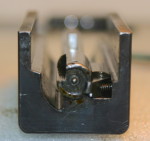
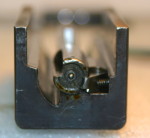



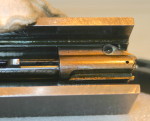
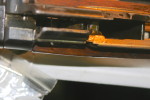
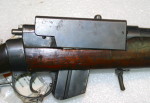



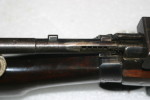
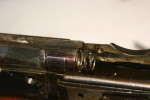




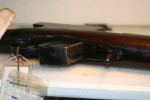

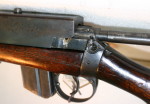
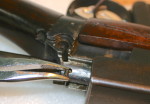
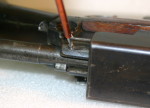
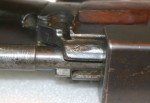
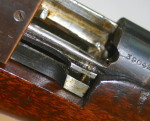

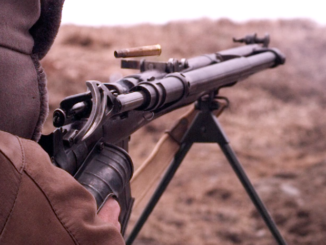
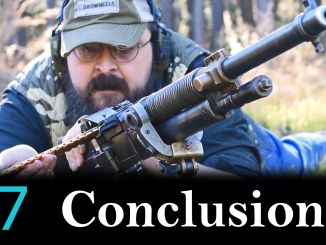

It is similar to WW1-era Pedersen Device in concept (semi-auto version of full-power rifle firing pistol-size cartridge) with difference that this is fixed (Springfield/Pedersen can be switched from .30-06 to .30-18 and back to .30-06)
Schmeisser also designed rifle-look-alike-sub-machine gun, the MK.36,III
http://world.guns.ru/smg/de/submachine-gun-schmeisser-mk36-e.html
It was designed before the wa, to be friendly for soldiers which were trained to use Karabiner 98k.
Timing is everything. Had this been developed in 1939 or 1940 it might have gone somewhere. By 1943 its niche was better filled by the Sten.
I have to agree with this. By 1943, such a firearm would have been little more than a burden to an already overtaxed British logistical system. I’ve handled and fired every mark of Sten except the Mk. 1, and although a bit cheap and crude, they all functioned fine. Granted, this was under range conditions, but all in all, they seem a decent compromise between cost, rapid production, and functionality. The same could be said about the M1 carbine being superfluous, had the M3 Greasegun been de-bugged and available in quantity at the same time. However, like the M1 carbine, the Howard Francis could have had a future in the civilian world as a “field rifle” for small/medium game and pest control, where a .22 is too light, but a full-powered rifle would be a problem due to range/penetration/noise concerns, or for police use, where a light and accurate shoulder weapon with “less intimidating” appearance than a submachine gun has advantages. It could have provided an extended post-war service life to many SMLEs that were around at the time, and such conversions could have had some economic viability in the post-war era.
Perhaps the M-1 carbine might have left the M3 Grease gun superfluous. Some argue that had the Garand been adopted as a ten-shot .276″ Pedersen rifle a pound or two lighter than the .30-06 version there’d have been no need for the carbine’s development. To my admittedly limited understanding, the .30 carbine was to have replaced the .45acp M1911 and Thompson, but instead just added to the logistics burdens. Particularly given that .30-06 was issued packed into five-round chargers for M1903s and M1917s, packed for BAR magazines, and packed in en-bloc clips for the Garand rifle as well as on belts for machine guns… Somewhat negating the MacArthur position to retain the .30-06 cartridge for all arms.
The M14 was to have eliminated the BAR, M1, and carbine with a single weapon… Didn’t really work as a BAR replacement hence the M60… And so on it goes. A universal cartridge took a big pause there for a time I guess…
If anyone could come up with a Pedersen device for any of the common variety Mosin-Nagant rifles, and keep it somewhat reasonably priced, that’d probably replace a lot of my other firearms, frankly! Even if it used the crazy M1895 gas-seal nagant revolver cartridge.
Fantastic exposition of an interesting prototype.
“Even if it used the crazy M1895 gas-seal nagant revolver cartridge.”
Tokarev designed sub-machine gun firing 7.62x38R cartridge:
https://ru.wikipedia.org/wiki/Пистолет-пулемёт_Токарева_(1927)
It uses Nagant cartridge variant with tapered case muzzle unlike Nagant straight case, to allow proper ramming cartridge into chamber. Anyway it reliability was low and was not accepted into service but 300 to 600 examples were made. Some were used during Great Patriotic War (in January 1942, Kalinin Front)
You beat me to that, Daweo. I don’t if this is just my memory playing tricks, but I remember having read somewhere that the Tokarev sub-machine gun (of which a semi-auto carbine prototype was also made) was intended as a police weapon of sorts.
Spasibo, Daweo. Personally, I like the Degtyarev version with the top-mounted pan magazine…a precursor to the American 180 .22 perhaps?… feeding the M1895 cartridges into the rimmed-ammo SMG.
I hear this stated so frequently by those who would love to see a new production Pederson device. Immediately, it’s followed by people saying they’d be interested in it, that it would never happen because there isn’t enough interest (which is absolute crap, there’s plenty of interest in one), or that it would never happen because there isn’t enough interest, but that if it *does* happen they were interested.
Fun fact, there was one working prototype of the Pedersen device built for use with a Mosin Nagant (presumably to try and make use of the ton of rifles we bought as surplus to save Remington and NEW). I have absolutely no idea how it faired, but it is interesting that it did exist.
It’s bolt looks very heavy to say it’s only in 7.63mm, it’s way bigger than a Ppsh’s in 7.62x25mm.
Puzzling weapon.
I don’t understand the point of this “filler” magazine, why manufacturer it as a part… It’s a sealed unit and seemingly detaches like the real mag “on another picture, see bottom of this thread” surely as a filler, you’d just cut a mag in half and weld this bit in place to support the actual magazine.
I wonder if it was some sort of double feed thing, like a AN94 but not, perhaps not, but still. It’s action seems odd for “I know it’s using another weapons bits, to actuate it”
Probably not a double feed thing, of some description. The bolt is bulky but not solid,
perhaps it is actually of a similar mass to a Ppsh’ish.
Round catcher… That s&w carbine with the funny tube behind the mag for ejection, it doesn’t look as if the bolt moves that far back though.
The magazine on the illustration aforesaid resembles a 20rnd Mauser 712 magazine externally which were 7.63mm
Which might fit in that mag well, at a push.
Okay, I think I’ve finally concocted some sort of weapon of choice scenario for this topic!
Given a choice, what pistol caliber “rifle” or squad-automatic-weapon would you have to accompany a shock trooper unit armed primarily with submachine guns intended for urban warfare?
1. ZK-383
2. LAD gas-operated submachine gun in 7.62×25 Tokarev
3. Danuvia 39M or 43M
4. Pedersen device improvised for Mosin-Nagant rifle, chambered for 7.62x38mmR Nagant or 7.62×25 Tokarev
5. Militarized version of a Ruger Police Carbine with bayonet lug, select-fire capability, and scope
6. El Tigre or Destroyer Carbine
7. De Lisle silent carbine for assassinations
8. C96 trench carbine (40 round mag included)
9. Or per the usual, screw the budget and add your favorite toys to this list
This activity is completely voluntary. You are not required to participate if you do not wish to do so. Please keep any and all criticism of this post humane and free of foul language.
Thank you,
Cherndog
the destroyer, as i own one, and find it very accurate and able to reach out a suprising distance!
Or a “pre-sporterized” version that is useless for collecting.
Me too. On that list I’ve got the 9mm Largo Destroyer carbine and the Beretta version of the Ruger LE pistol-caliber carbine.
From the list I’d go for the Mosin-Pedersen or the Danuvia. An M1903 Mk.I fitted with the Pedersen device and the 400 cartridges packed in ten magazines? Yes please.
“LAD gas-operated”
LAD (ЛАД) sub-machine gun is not gas-operated, it work on blow-back principle, it is (unlike most 7.62×25 fire-arms) belt-fed and has bi-pod
Whoops! Sorry about that!
“for consideration in 1943”
They were digging up ideas from 25 years ago? Was Howard a veteran by any chance?
It would have been great in 1915-1918. Even right after the war while there had to have been large numbers of SMLE available to convert.
If nothing else, it would have been a great moral booster to have been able to hand out one of these to everyone who joined the English Home Guard after Dunkirk.
OT, but I can’t really understand why in the last 100 years any industrialized country would find it’s self be short of small arms when a war starts. The only thing I can think of is that governments forget the main reasons they exist in the first place and get bogged down in secondary things.
More likely the bureaucrats and accountants got in the way. If you can’t afford to produce any more equipment or even import or process materials needed for it, how can you think about keeping the other team out of your living room? England was nearly bankrupt by 1940 unless I’m totally wrong…
Indeed they do. Plus after the threat is gone, the hope that there won’t be another war turns into a believe.
Seems the Swiss are the only ones who have been able to keep it’s nation equipped for whatever may come down the road.
Well, Martin, the Swiss could afford to see what was going on through business connections and “personal” connections behind closed doors. Plus, most countries failed at invading Switzerland due to the Swiss having an altitude-type terrain advantage. The Swiss had brilliance at figuring out several things about small arms development to suit a small militia-based army. By 1866, every Swiss militiaman got a rifle that could outdo the other team in terms of rate of fire and ammunition capacity–the Vetterli. Just 23 years later, the Schmidt-Rubin series began and outdid everyone else in terms of rate of fire, accuracy at 2 kilometers against an invader’s cranium, and durability along with production quality. In fact, the K31, which is not a Schmidt-Rubin, but very similar, can hit within a minute of arc, the rounds straying only half an inch from the intended point of aim at a distance of 100 yards… How do the Swiss afford to do that? Oh, perhaps something to do with tight security over a bank account or tons of high-quality manufactured goods found nowhere else in Europe… Or am I wrong?
The Francis SLC wasn’t exactly recoil-free – trial notes suggest that it did have some recoil and that it threw off the aim of those who tried it out.
Also interestingly, the Francis carbine was not a British design. I believe it was designed in West Africa. It was shipped over to Britain for testing.
http://firearms.96.lt/pages/Francis.html Thats a link from your webpage about this curious firearm, one model seemingly still exists however- This one in Leeds apparently. There’s a Simonstown in South Africa, as oppose West Africa perhaps Howard Francis was South African.
7.63mm Might have been more to do with South Africa, perhaps they had alot of Broom handle Mausers laying around.
Via Ex German East Africa etc post WW1
Some Boers, were German inclined.
And .303 didn’t need re-barreling, Churchill had a C96 at some point if I remember.
Yes, you’re right; Simonstown is in South Africa. I don’t know where I got West Africa from. Thus, Howard Francis was probably South African.
What’s interesting is that a lot of commonwealth nations had their own Lee-Enfield conversions; South Africa had the Francis and the Rieder, Australia had the Ekins, and New Zealand had the Charlton.
Do you mean this was south africas conversion by that Francis, and other commonwealth countries made self loading pistol calibre conversions of… Smles, out of interest around the same time as each other?
Were they in 7.63mm because it fits the .303 bore these other ones, did Britain have one of these conversions… Seems to me it was about converting smles then because they were being replaced, maybe Britain didn’t bother because it was imagined enough smgs would be available regardless here via stens etc.
Charlton… New Zealand, the “bren” conversion of an obsolete enfield design… Well it’s along the same line, reusing weapons which had been replaced.
Building something like this would make an interesting toolroom project. I wouldn’t cut up a milsurp bolt action — let those old soldiers be — but I’ll bet you could find a still-sound beater of a sporting rifle to work with.
Or a “pre-sporterized” version that is useless for collecting.
Is it a Mk3 Mk3* Smellie, apparently the Mk3 had a cut off… So the part were it went, might be visible on this if it is a Mk3 is there any markings suggesting south Africa.
In relation to the Francis being a South African, did South Africa still use the SMLE after we used the no.4 just wondering why it wasn’t a No.4… Was the idea, turn old SMLE’s into smgs.
I don’t know how different the No.4 and Smle are, wether an smle conversion would fit the No.4 and vice versa.
I mean it’s not a bad idea, if the no.4 was an entirely new rifle… Instead of scrapping the Smles, turn them into Smgs. He might have been able to make it better than this version, when did Britain scrap/change the Smle to the no.4? In the 40’s or, how about in South Africa.
On the drawing from a link I posted above off Augfc’s website, it shows two magazines… Well, say the filler part and a magazine but separately. And there’s an illustration of them together.